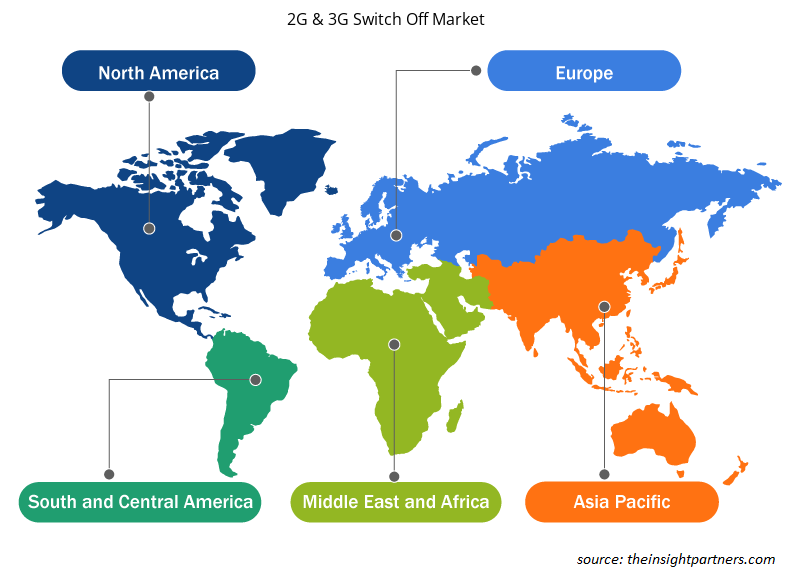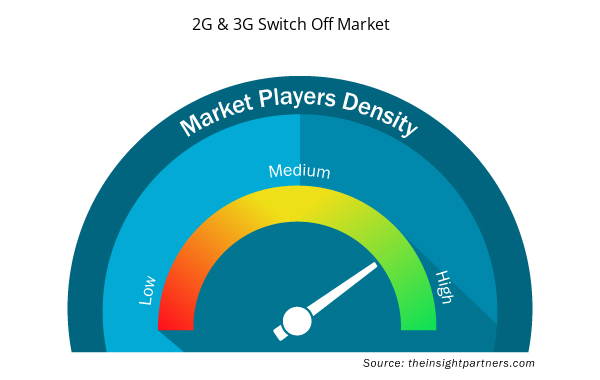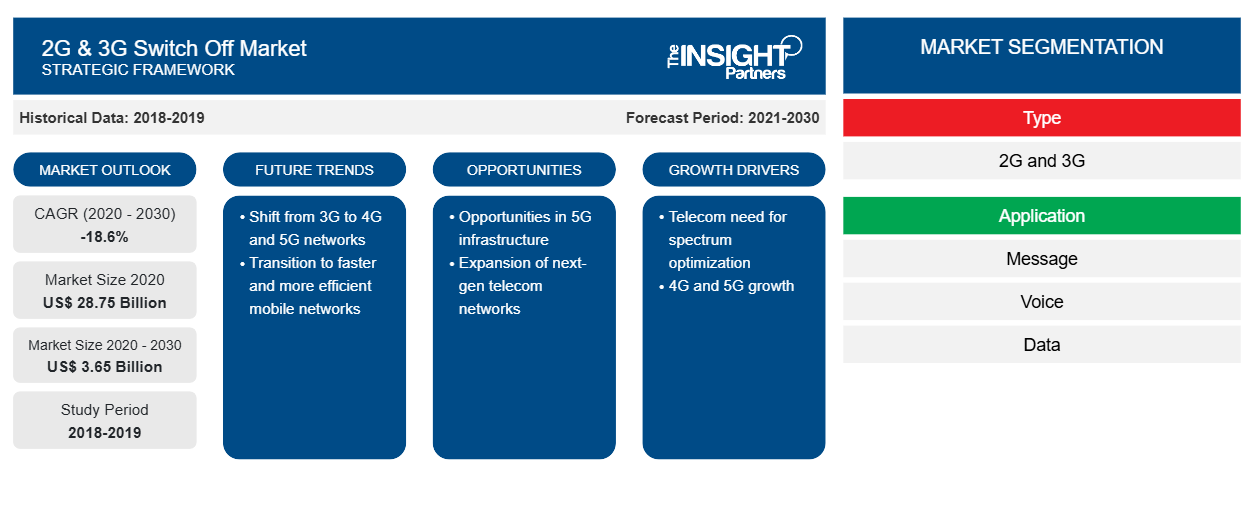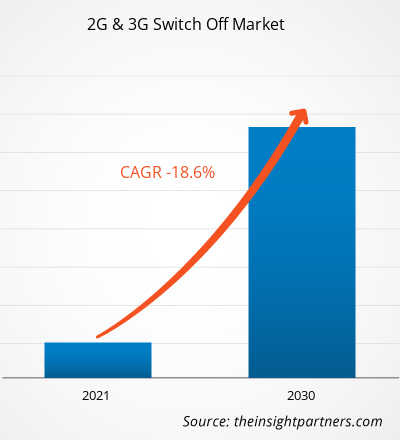[研究报告] 2020 年 2G 和 3G 切换市场规模价值 287.5 亿美元,预计到 2030 年将下降至 36.5 亿美元;预计 2020 年至 2030 年的复合年增长率为 -18.6%。
2G 和 3G 关机市场 - 分析师观点:
5G 的快速扩张促使移动网络运营商 (MNO) 关闭其 2G 和 3G 网络并将其重新用于 5G 部署。这有力地推动了 2G 和 3G 切换市场的增长。目前,许多智能家居设备(例如家庭安全和智能电表)都在 2G 和 3G 网络上进行通信。家庭安全系统通常使用 3G 备用通信器联系监控中心,以防发生断电或未经授权的线路篡改等事件。2G 和 3G 是物联网和机器对机器 (M2M) 设备,因为它们比 4G 模块更具成本效益。此外,4G 的速度与发送少量数据的物联网或 M2M 设备无关。蜂窝物联网设备始终处于联网状态,它们通过移动通信传输数据的能力源于保持永久漫游状态的 M2M 用户识别模块 (SIM) 卡。它允许它们利用不同运营商的移动网络,并自主地从一个连接切换到另一个连接以保持持续连接。因此,速度较慢的 2G 和 3G 连接仍然足够快,符合当今的标准。因此,2G 和 3G 网络的淘汰会导致依赖 2G 或 3G M2M 用户识别模块 (SIM) 卡的物联网设备的连接选项有限。
工业物联网设备预计将受到比住宅物联网设备更大的影响,因为目前的 5G 部署和未来即将推出的 6G 需要淘汰旧技术。蜂窝连接在工业物联网 (IIoT) 中发挥着重要作用。组织需要在农业、制造业、能源、零售、医疗保健和物流等垂直行业中跨不同地理区域保持持续连接。当设备不断移动、固定在偏远地区或按需部署时,蜂窝连接变得至关重要。相比之下,大多数现代智能家居设备都是通过家庭 Wi-Fi 网络连接的。因此,预计 2G 和 3G 的淘汰对智能家居/联网建筑应用的影响微乎其微。例如,英国智能计量的全国推广在很大程度上依赖于基于 2G 的 M2M 连接。根据英国政府的统计数据,2022 年英国家庭共安装了 360 万台智能电表,比 2021 年增长了 4%。因此,英国的 3G 正在关闭(预计 2025 年完成),早于 2G(预计 2033 年完成),这也推动了 2G 和 3G 关停市场的增长。然而,对于全球任何新设备的推出,设备制造商都必须考虑到 2G 和 3G 之后 4G 即将消亡。例如,Sprint LTE 网络已于 2022 年 6 月 30 日关闭。
定制此报告以满足您的需求
您可以免费定制任何报告,包括本报告的部分内容、国家级分析、Excel 数据包,以及为初创企业和大学提供优惠和折扣
- 获取此报告的关键市场趋势。这个免费样品将包括数据分析,从市场趋势到估计和预测。
2G 和 3G 关闭市场概览:
大量设备和服务依赖于老一代网络,并受到 2G/3G 退网的影响。其中包括个人健康报告、家庭安全、工业设备自动化、实时性能和自主操作。这些领域使用的许多设备将使用数十年。例如,过去十年生产的许多新车,甚至是 2021 年生产的有些新车,都配备了基于 3G 的联网服务。这些包括位置数据、紧急呼叫服务、Wi-Fi 热点、远程锁定/解锁功能、语音助手、智能手机应用程序连接,甚至礼宾服务。此外,SOS 系统和路边警报都是基于网络的功能,也会受到影响。丰田、雷克萨斯、日产和现代在 2019 年之前发布的车辆都容易受到此次退网的影响。
安全系统通常通过蜂窝网络运行。2016 年初,3G 网络成为安全面板使用的标准通信技术。随着传统铜质固定电话的淘汰,人们开始转向使用蜂窝技术传输信息的无线安全系统。如果已安装的报警系统基于兼容 3G 的通信器,那么一旦运营商开始淘汰 3G 网络,无论安全提供商是谁,它都将无法正常工作。在这种情况下,需要更换蜂窝通信器才能在新网络上运行。
全球多家网络运营商已宣布将在 2023 年逐步淘汰 2G 和 3G,从而推动 2G 和 3G 切换市场的增长。例如,在这种转变最为突出的欧洲,Orange 是最新采用这一趋势的运营商之一,截至 2022 年 8 月,该公司宣布,传统的 2G 和 3G 将在 2025 年至 2030 年间逐步淘汰。
2G 和 3G 关闭市场驱动因素:
5G 技术的出现推动 2G 和 3G 关机市场增长
新兴的5G网络比 4G 具有更高的容量、更低的延迟和更大的带宽。这些网络增强功能预计将影响全球人们的工作、生活和娱乐方式。据英特尔公司称,5G 将提供比 4G 多 1,000 倍的容量,为物联网发展铺平道路。5G 和物联网是一个很好的组合,它有可能重塑无线网络和互联网的使用方式。由于能够轻松地与数百或数千台设备进行通信,城市、工厂、农场、学校和家庭的新应用和用例将蓬勃发展。向 5G 的过渡可能是未来几年智能手机行业最重要的增长引擎。基于 5G 的移动网络的进步实现了低延迟,这为新的机会开辟了道路,包括虚拟现实体验、多人移动游戏、工厂机器人和自动驾驶汽车应用,对于这些应用来说,快速响应被视为一项重要标准。因此,由于5G技术的巨大优势,许多国家正在采用它,从而推动了2G和3G切换市场的增长。
2G 和 3G 关闭市场细分分析:
2G 和 3G 关机市场根据类型和应用进行分类。根据类型,2G 和 3G 关机市场分为 2G 和 3G。3G 细分市场在 2020 年占据了更大的市场份额,而 2G 细分市场则下降得更快。在应用方面,市场细分为消息、语音、数据和物联网。随着行业转向支持 5G 的设备,物联网细分市场正在以最快的速度减速。按地域划分,2G 和 3G 关机市场细分为北美、欧洲、亚太地区 (APAC)、中东和非洲 (MEA) 和南美 (SAM)。亚太地区采用 5G 的速度最快,2G 和 3G 关机市场下降速度更快。
运营商正在关闭 2G 和 3G 网络以释放 4G 和 5G 频段,从而推动 2G 和 3G 切换市场的发展。但是,安装 4G 和 5G 等高速网络需要某些基础设施,包括频谱、站点和光纤;这些基础设施的安装成本相当高。部署 5G 基站需要大量的前期成本,包括获取土地或屋顶空间、购买和安装设备、获得许可证以及确保电力供应和回程连接。这些成本可能成为电信运营商和政府的障碍。电信运营商必须参与昂贵的频谱拍卖才能获得 5G 所需的频段。这些拍卖成本增加了总体基础设施支出。
5G 网络由于覆盖范围较短、频段较高,需要更密集的基站部署。因此,需要更多基站来覆盖相同区域,从而增加基础设施成本。尽管如此,由于 5G 的优势,它正以惊人的速度被采用,取代 2G 和 3G 技术。印度、中国、马来西亚、墨西哥、南非和巴西等发展中国家的 5G 用户采用率正在上升,并导致 2G 和 3G 切换市场增长。
2G 和 3G 关闭市场区域分析:
2020 年亚太地区 2G 和 3G 关机市场规模价值 37.1 亿美元,预计到 2030 年将达到 1.1 亿美元;预计 2022 年至 2030 年的复合年增长率为 -29.4%。亚太地区 2G 和 3G 关机市场分为澳大利亚、印度、中国、日本、韩国和亚太地区其他地区。据全球技术研究和 IT 咨询公司 ISG 称,预计到 2025 年,亚太地区将有 29 家运营商停止使用 2G/3G 网络。印度计划在 2023 年底停止使用 2G。沃达丰将在 2022 年停止使用 2G,而日本在 2012 年宣布在全国范围内停止使用 2G。所有这些情况都促进了 2G 和 3G 关机市场的增长。
一些地区运营商正在关闭 2G 和 3G 网络,这对 2G 和 3G 切换市场增长产生了积极影响。例如,截至 2021 年 2 月,以“Vi”品牌提供服务的电信运营商 Vodafone Idea Ltd (VIL) 将在 2022 财年之前完全关闭印度所有地区的 3G 服务,并转向 4G。该网络运营商已准备好提供 5G。因此,该地区 2G 和 3G 网络的多次关闭将促进 2G 和 3G 切换市场的发展。
2G 和 3G 关闭市场关键参与者分析:
AT&T Inc、BCE Inc、中国移动有限公司、德国电信公司、KDDI 公司、NTT 数据公司、Orange SA、Telefonica SA、Telenor ASA 和沃达丰集团是本研究分析的主要 2G 和 3G 切换市场参与者。此外,还研究和分析了其他几家重要的 2G 和 3G 切换市场参与者,以全面了解全球 2G 和 3G 切换市场及其生态系统。
2G & 3G 关闭市场报告范围
2G 和 3G 关闭市场区域洞察
Insight Partners 的分析师已详细解释了预测期内影响 2G 和 3G 关机市场的区域趋势和因素。本节还讨论了北美、欧洲、亚太地区、中东和非洲以及南美和中美洲的 2G 和 3G 关机市场细分和地理位置。

- 获取 2G 和 3G 关机市场的区域特定数据
2G & 3G 关闭市场报告范围
| 报告属性 | 细节 |
|---|---|
| 2020 年市场规模 | 287.5亿美元 |
| 2030 年市场规模 | 36.5亿美元 |
| 全球复合年增长率(2020 - 2030 年) | -18.6% |
| 史料 | 2018-2019 |
| 预测期 | 2021-2030 |
| 涵盖的领域 | 按类型
|
| 覆盖地区和国家 | 北美
|
| 市场领导者和主要公司简介 |
|
市场参与者密度:了解其对商业动态的影响
2G 和 3G 关机市场正在快速增长,这得益于终端用户需求的不断增长,而这些需求又源于消费者偏好的不断变化、技术进步以及对产品优势的认识不断提高等因素。随着需求的增加,企业正在扩大其产品范围,进行创新以满足消费者的需求,并利用新兴趋势,从而进一步推动市场增长。
市场参与者密度是指在特定市场或行业内运营的企业或公司的分布情况。它表明在给定市场空间中,相对于其规模或总市场价值,有多少竞争对手(市场参与者)存在。
在 2G 和 3G 关机市场运营的主要公司有:
- 美国电话电报公司
- BCE公司
- 中国移动有限公司
- 德国电信公司
- KDDI公司
免责声明:上面列出的公司没有按照任何特定顺序排列。

- 了解 2G 和 3G 关闭市场顶级关键参与者概况
2G 和 3G 关闭市场最新发展:
- 2023 年 12 月,O2 斯洛伐克宣布计划从 2024 年 1 月开始逐步淘汰其 3G 网络,理由是减少使用量并专注于现代 4G 和 5G 技术。该公司将于 2024 年 1 月底开始关闭斯洛伐克指定地区的 3G 网络,并在未来两年内逐步将关闭范围扩大到全国。O2 指出,由于 4G 和 5G 技术的出现,3G 的使用量已大幅减少,目前已达到最低水平。
- 2023 年 7 月,新加坡电信、星和和 M1 公布了从 2024 年 7 月 31 日起关闭新加坡 3G 网络的计划,三家公司都将重新利用频谱来改善 5G 服务。这些运营商在一份联合声明中指出,近年来,他们一直在敦促 3G 用户迁移到 4G 或 5G 服务,并计划在未来几个月采取措施帮助用户转向其他网络。
- 历史分析(2 年)、基准年、预测(7 年)及复合年增长率
- PEST 和 SWOT 分析
- 市场规模价值/数量 - 全球、区域、国家
- 行业和竞争格局
- Excel 数据集



Report Coverage
Revenue forecast, Company Analysis, Industry landscape, Growth factors, and Trends

Segment Covered
This text is related
to segments covered.

Regional Scope
North America, Europe, Asia Pacific, Middle East & Africa, South & Central America

Country Scope
This text is related
to country scope.
常见问题
The incremental growth expected to be recorded for the global 2G & 3G switch off market during the forecast period is US$ -17.09 billion.
The global 2G & 3G switch off market was estimated to be US$ 28.75 billion in 2020 and is expected to decline at a CAGR of -18.6% till 2030.
The global 2G & 3G switch off market is expected to reach US$ 3.65 billion by 2030.
The key players in the global 2G & 3G switch off market are AT&T Inc, BCE Inc, China Mobile Ltd, Deutsche Telekom AG, KDDI Corp, NTT Data Corp, Orange SA, Telefonica SA, Telenor ASA, and Vodafone Group Plc.
Government regulations to shut down 2G and 3G is anticipated to play a significant role in the global 2G & 3G switch off market in the coming years.
The emergence of 5G technology, increasing adoption of industry 4.0 and edge computing are the major factors that propel the global 2G & 3G switch off market.
Trends and growth analysis reports related to Technology, Media and Telecommunications : READ MORE..
The List of Companies - 2G and 3G Switch Off Market
- AT&T Inc
- BCE Inc
- China Mobile Ltd
- Deutsche Telekom AG
- KDDI Corp
- NTT Data Corp
- Orange SA
- Telefonica SA
- Telenor ASA
- Vodafone Group Plc
The Insight Partners performs research in 4 major stages: Data Collection & Secondary Research, Primary Research, Data Analysis and Data Triangulation & Final Review.
- Data Collection and Secondary Research:
As a market research and consulting firm operating from a decade, we have published and advised several client across the globe. First step for any study will start with an assessment of currently available data and insights from existing reports. Further, historical and current market information is collected from Investor Presentations, Annual Reports, SEC Filings, etc., and other information related to company’s performance and market positioning are gathered from Paid Databases (Factiva, Hoovers, and Reuters) and various other publications available in public domain.
Several associations trade associates, technical forums, institutes, societies and organization are accessed to gain technical as well as market related insights through their publications such as research papers, blogs and press releases related to the studies are referred to get cues about the market. Further, white papers, journals, magazines, and other news articles published in last 3 years are scrutinized and analyzed to understand the current market trends.
- Primary Research:
The primarily interview analysis comprise of data obtained from industry participants interview and answers to survey questions gathered by in-house primary team.
For primary research, interviews are conducted with industry experts/CEOs/Marketing Managers/VPs/Subject Matter Experts from both demand and supply side to get a 360-degree view of the market. The primary team conducts several interviews based on the complexity of the markets to understand the various market trends and dynamics which makes research more credible and precise.
A typical research interview fulfils the following functions:
- Provides first-hand information on the market size, market trends, growth trends, competitive landscape, and outlook
- Validates and strengthens in-house secondary research findings
- Develops the analysis team’s expertise and market understanding
Primary research involves email interactions and telephone interviews for each market, category, segment, and sub-segment across geographies. The participants who typically take part in such a process include, but are not limited to:
- Industry participants: VPs, business development managers, market intelligence managers and national sales managers
- Outside experts: Valuation experts, research analysts and key opinion leaders specializing in the electronics and semiconductor industry.
Below is the breakup of our primary respondents by company, designation, and region:

Once we receive the confirmation from primary research sources or primary respondents, we finalize the base year market estimation and forecast the data as per the macroeconomic and microeconomic factors assessed during data collection.
- Data Analysis:
Once data is validated through both secondary as well as primary respondents, we finalize the market estimations by hypothesis formulation and factor analysis at regional and country level.
- Macro-Economic Factor Analysis:
We analyse macroeconomic indicators such the gross domestic product (GDP), increase in the demand for goods and services across industries, technological advancement, regional economic growth, governmental policies, the influence of COVID-19, PEST analysis, and other aspects. This analysis aids in setting benchmarks for various nations/regions and approximating market splits. Additionally, the general trend of the aforementioned components aid in determining the market's development possibilities.
- Country Level Data:
Various factors that are especially aligned to the country are taken into account to determine the market size for a certain area and country, including the presence of vendors, such as headquarters and offices, the country's GDP, demand patterns, and industry growth. To comprehend the market dynamics for the nation, a number of growth variables, inhibitors, application areas, and current market trends are researched. The aforementioned elements aid in determining the country's overall market's growth potential.
- Company Profile:
The “Table of Contents” is formulated by listing and analyzing more than 25 - 30 companies operating in the market ecosystem across geographies. However, we profile only 10 companies as a standard practice in our syndicate reports. These 10 companies comprise leading, emerging, and regional players. Nonetheless, our analysis is not restricted to the 10 listed companies, we also analyze other companies present in the market to develop a holistic view and understand the prevailing trends. The “Company Profiles” section in the report covers key facts, business description, products & services, financial information, SWOT analysis, and key developments. The financial information presented is extracted from the annual reports and official documents of the publicly listed companies. Upon collecting the information for the sections of respective companies, we verify them via various primary sources and then compile the data in respective company profiles. The company level information helps us in deriving the base number as well as in forecasting the market size.
- Developing Base Number:
Aggregation of sales statistics (2020-2022) and macro-economic factor, and other secondary and primary research insights are utilized to arrive at base number and related market shares for 2022. The data gaps are identified in this step and relevant market data is analyzed, collected from paid primary interviews or databases. On finalizing the base year market size, forecasts are developed on the basis of macro-economic, industry and market growth factors and company level analysis.
- Data Triangulation and Final Review:
The market findings and base year market size calculations are validated from supply as well as demand side. Demand side validations are based on macro-economic factor analysis and benchmarks for respective regions and countries. In case of supply side validations, revenues of major companies are estimated (in case not available) based on industry benchmark, approximate number of employees, product portfolio, and primary interviews revenues are gathered. Further revenue from target product/service segment is assessed to avoid overshooting of market statistics. In case of heavy deviations between supply and demand side values, all thes steps are repeated to achieve synchronization.
We follow an iterative model, wherein we share our research findings with Subject Matter Experts (SME’s) and Key Opinion Leaders (KOLs) until consensus view of the market is not formulated – this model negates any drastic deviation in the opinions of experts. Only validated and universally acceptable research findings are quoted in our reports.
We have important check points that we use to validate our research findings – which we call – data triangulation, where we validate the information, we generate from secondary sources with primary interviews and then we re-validate with our internal data bases and Subject matter experts. This comprehensive model enables us to deliver high quality, reliable data in shortest possible time.


 获取此报告的免费样本
获取此报告的免费样本